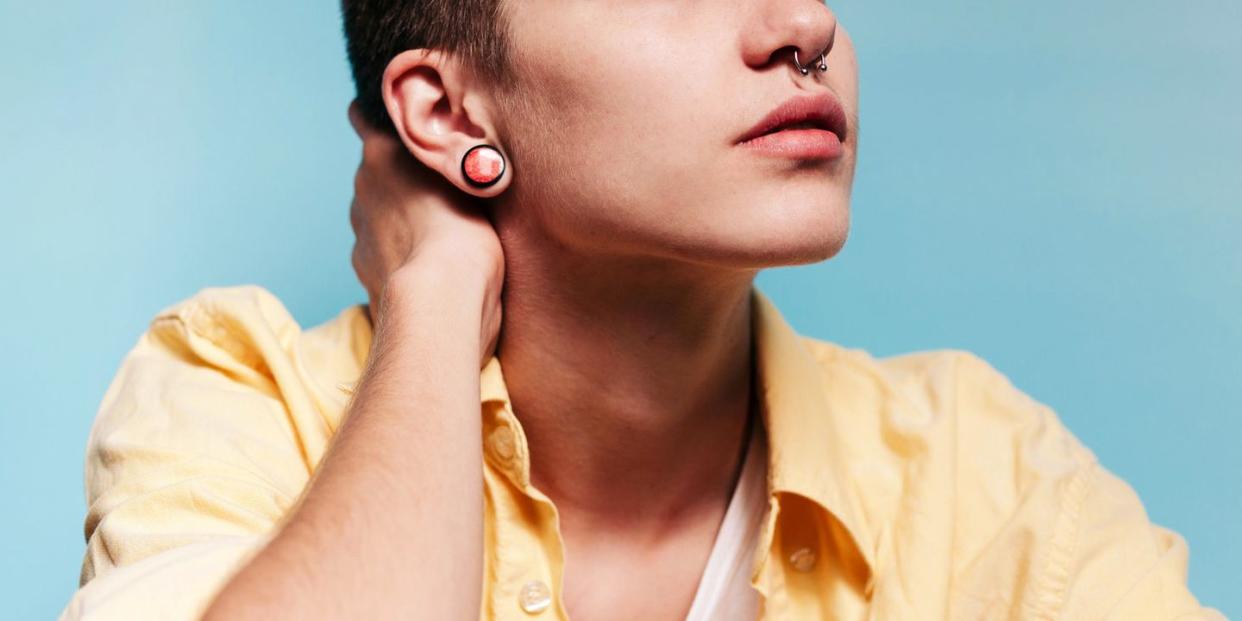What Does It Really Mean to Be Androgynous?

What does androgyny mean?
Androgyny refers to the gender expression of someone with both significant masculine and significant feminine characteristics, as Kyle Elliott, MPA, CHES, explains. It’s important to note though, that each person’s definition of androgynous can and will vary — what one person considers to be significantly masculine or feminine characteristics may be different than what another person considers.
Androgyny is not defined by the societal boundaries of “looking like a girl,” or “looking like a boy,” as Shawnnell Batiste, licensed therapist in Texas and Louisiana, explains, but rather a “pure self-expression.”
What does the term ‘androgyne’ mean?
When you see the term ‘androgyne,’ this refers to a person who identifies as androgynous.
Is being androgynous the same as sexual orientation?
Nope! “While often confused, gender identity, gender expression, sex, and sexual orientation are each distinct,” Elliot explains. Gender identity is how you feel, gender expression is how you express yourself, and sexual orientation refers to the gender(s) you’re attracted to. Androgyny is a gender expression, so it’s separate from gender identity, sex, and sexual orientation. You can be androgynous and be straight, gay, asexual, or any other orientation, as being androgynous has nothing to do with your sexual preferences, adds Katherin Winnick, sex coach at LetsTalkSex.net.
To help clarify the definition of androgyny further, here’s some more background on the term from writer Sophie Saint Thomas:
What comes to mind when you hear the word androgyny? Maybe it’s a celebrity, like David Bowie or Ruby Rose, who dresses and presents themselves in a way that toes the line between masculine or feminine. If so, you’ve nailed it—the word comes from the 14th century and is a combination of andr, for man, and gyne, meaning woman.
The term androgynous isn’t often used within the queer community these days—it’s mostly used within the fashion world, or you see it popping up to describe a pop star. “Androgyny is a way of presenting yourself with both masculine and feminine characteristics,” explains Kelly Wise, PhD, a New York City–based sex therapist.
While androgynous is more of a fashion term these days and not so much a term used within the queer community, it speaks to the societal pressure to look a certain way. For instance, gender isn’t just a binary of male and female—it includes trans folks (someone whose gender assigned at birth by a doctor does not match their gender identity), genderqueer folks (someone whose gender fluctuates and has different gender identities at different times) and nonbinary folks (someone who doesn’t identify on the gender binary or solely as one of those two genders).
Likewise, sexual orientation doesn’t just include straight and gay but rather encompasses those who are bisexual (attraction to your own gender and genders other than your own), pansexual (attraction to people regardless of their gender), and queer (an umbrella term within the LGBTQ community).
“There’s pressure if you don’t fit within the gender binary, to become that middle ground,” says Liz Powell, PhD, a LGBTQ-friendly sex therapist. “You can’t present as someone who fits within the gender binary because then people get confused.”
I relate to this as a bisexual and queer person—despite being bisexual and having a girlfriend, I’m very “high-femme,” meaning I’m a queer person who presents and engages in traditionally feminine clothing, makeup, and activities like spa days. Sometimes when I’m mistaken for straight, I wonder, if I looked more androgynous, would that happen less?
“Androgyny was a term initially created to describe people who didn’t fit within the expressions of gender that were expected of them, but it doesn’t necessarily speak to their internal gender identities,” Powell says. “I have a good friend who does not identify within the gender binary, who dresses exclusively in long dresses and wears makeup. So their presentation is very clearly along femme lines, but that femme-ness does not make them cisgender.”
Androgyny as a style choice—something anyone can play with—can be fun. But it’s still important to maintain the distinction between how someone chooses to look or dress and how they identify on the inside. Expecting a certain presentation—like for femme-presenting people to dress “girly” or masculine-presenting people to dress “manly”—is harmful.
“To me, a very limited way of thinking about androgynous is how gender neutral–clothing is almost always men’s clothing,” Powell says. “The idea is that it’s okay for women to wear men’s clothing, it’s okay for them to want to present closer to men, but anyone who was assigned male at birth and wants to wear dresses or makeup, or look more generally femme, that’s a problem.” It shouldn’t be, because anyone should be allowed to explore their style, and I can’t be the only one who finds men in makeup hot.
So explore and encourage yourself and others to enjoy androgynous looks—just remember it’s not a term often used within LGBTQ circles because we have our own terms and phrases, and it’s a bit outdated.
And just one more friendly reminder: The way someone dresses doesn’t define their gender or orientation.
You Might Also Like

